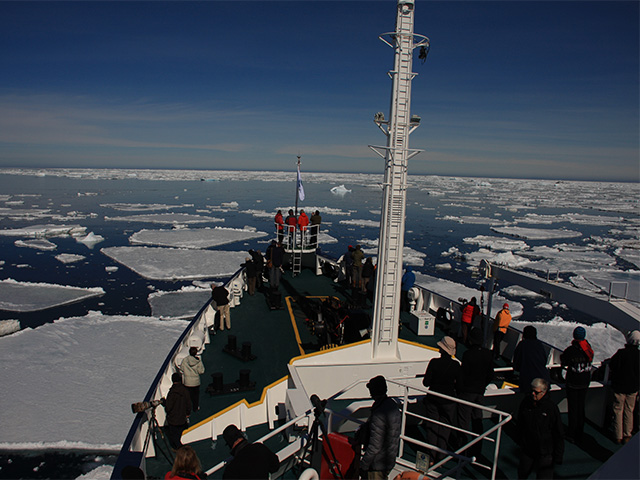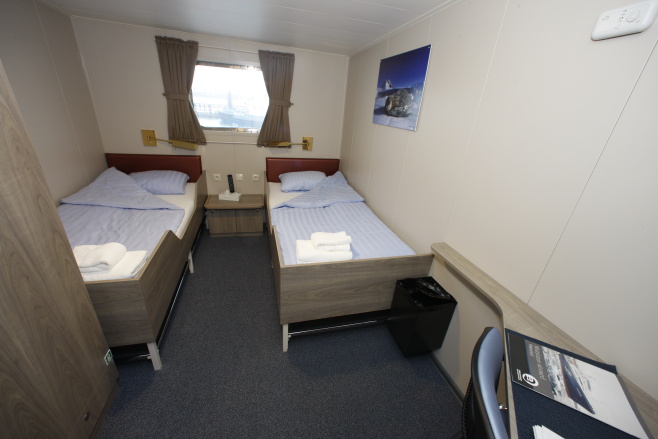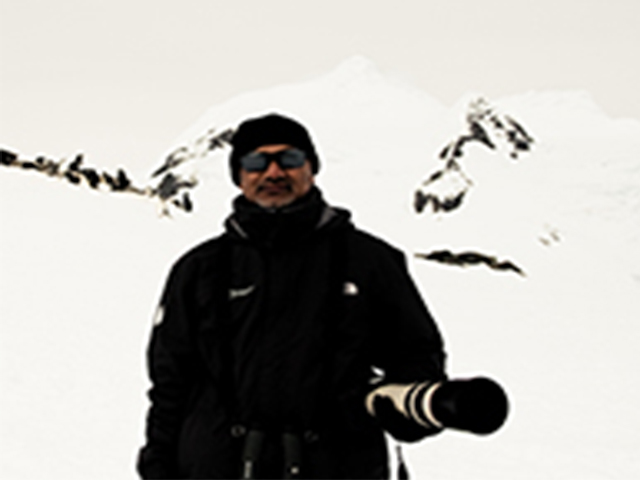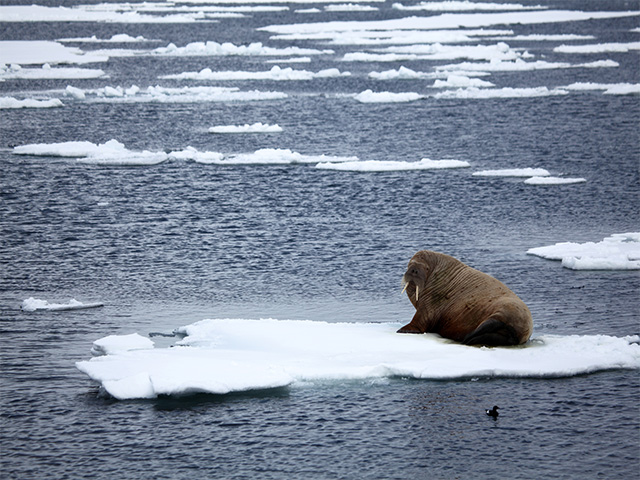- 1Longyearbyen, Norway
Today, we arrive in Longyearbyen, the administrative capital of the Spitsbergen archipelago, of which West Spitsbergen is the largest island. Before embarking on this spectacular journey, you can take a stroll around this former mining town, whose parish church and Polar Museum are well worth a visit. Early evening, the ship will sail out of Isfjorden. For the next nine days our stay will be aboard the M/v "Plancius", a vessel with 53 passenger cabins and a capacity to accommodate 114 passengers.
Spitsbergen is an Arctic archipelago about 650 kilometers (400 miles) north of Norway. The archipelago ranges from Bear Island (74 degree N) to Rossøya (81 degree N). It is by far the largest wilderness area of Europe. It covers an area of about 62,500 square kilometers, which is roughly the size of Ireland. About 60% of the land is glaciated. As Spitsbergen lies far within the Arctic circle, it experiences the midnight sun from April to August. At this time of year the sun is above the horizon for 24 hours a day!
Since 1925, Norway has sovereignty over Spitsbergen according to the international Spitsbergen Treaty. The Norwegian name for the archipelago is Svalbard. The name Spitsbergen was given by the Dutch explorer Willem Barentsz. The meaning of the name Spitsbergen in the Dutch language is "Jagged Peaks" because of the sharp pointed mountains that Barentsz met in the north-west of Spitsbergen. Spitsbergen, which has a population of about 3000 in 4 settlements, is to this day virtually an unspoilt wilderness. Imagine a place the size of Ireland with only about 50 kilometers (30 miles) of road!
Longyearbyen has approximately 2000 inhabitants and happens to be one of the world's northernmost villages. It is a modern village with a wide range of facilities such as a supermarket, tourist shops, several pubs and hotels, a cinema, a swimming pool, a sports hall and a church. Longyearbyen even has its own university, the UNIS, that offers Arctic studies.
Isfjord, with its vast tundra and abundant reindeer population, Longyearbyen and the Russian mining settlement, Barentsburg, gives one a very good opportunity to see Atlantic Puffins, Geese, Skuas, Svalbard Reindeers, Arctic Foxes and Belugas.
Meals: DinnerAccommodation: M/v ‘Plancius' - 2Krossfjorden to Ny Ålesund
Heading north along the west coast, we arrive by morning in Krossfjorden, where we go on the zodiacs (small inflatable boats that have a capacity of around ten to eleven passengers) for a cruise along the sculpted front of the 14th July Glacier. On the green slopes near the glacier, a wide colorful variety of flowers bloom, while large numbers of Kittiwakes and Brünnich’s Guillemots nest on the nearby cliffs. Look out for Arctic Foxes, patrolling the base of the cliffs, and Bearded Seals, cruising this fjord!
In the afternoon we sail to Ny Ålesund, the world’s northernmost settlement. Once a mining village, Ny Ålesund was served by the world’s northernmost railway, which can still be seen. Ny Ålesund is now a research centre. Barnacle Geese, Pink-footed Geese and Arctic Terns breed close to this village. Visitors interested in the history of Arctic exploration would want to walk to the anchoring mast used by Amundsen and Nobile in the airship Norge in 1926 and Nobile in the airship Italia in 1928 before their flights to the North Pole.
In the beautiful Kongsfjord the northernmost of the four settlements on Spitsbergen can be found Ny-Ålesund. This village even boasts of being the northernmost settlement in the world at latitude 78° 55′ N. Originally a mining settlement it is now a privately owned village that sells services to scientists—in short, an Arctic laboratory, it is a village for scientists. Ny-Ålesund is inhabited by a permanent population of approximately 35 persons. In summer up to 120 international scientists work here. Their research includes environmental studies, for instance climate change, geology, biology, oceanography, zoology and much more.
Meals: Breakfast, Lunch, DinnerAccommodation: M/v ‘Plancius' - 3Ytre Norskøya to Raudfjord
Today, on the offshore island of Ytre Norskøya, we visit a 17th century Dutch whaling site, whose large graveyard is a reminder of the hardships and dangers of life here at the time. The island’s bird life is prolific, with colonies of Little Auks, Black Guillemots, Brünnich’s Guillemots, Puffins and Arctic Skuas accessible to visitors. Eastwards, we visit Raudfjord on the north coast of West Spitsbergen, a beautiful fjord dominated by spectacular glaciers and favored by Ringed and Bearded Seals. The cliffs and shoreline of the fjord also support thriving seabird colonies and surprisingly rich vegetation, which flourishes in sheltered spots.
In the evening the campers can go ashore and spend the night here.
Ytre Norskøya retains the remains of a whaling station that existed on the southern side of the island; possibly rivaling Smeerenburg in size. It was Europe's northernmost outpost ever established until the early 19th century, and the most northerly permanent settlement established of any size until the 1950s.
The station had as many as nine tryworks, some having a single furnace, others having two. To the west of these structures were buildings used by the men working ashore. Further west is found one of the largest grave sites in Spitsbergen, where 165 graves have been found. The station was abandoned in 1670.
Meals: Breakfast, Lunch, DinnerAccommodation: Camping in Raudfjord - 4Raudfjord
On day four, we will spend the entire day in the Raudfjord system. Raudfjord, on the north coast of West Spitsbergen, is a beautiful fjord with spectacular glaciers. It is home to Ringed and Bearded Seals, Seabird colonies and surprisingly rich vegetation. Here, we have a good chance to see Polar Bears, for instance, near Hamilton Glacier, or more towards the head of the fjord.
In addition, we have ample opportunity to go on long walks here, as well as kayaking and snow-shoe walking. The group that wants to set off on a trekking expedition will start out on their three day trip to the east, to be picked up at the east side of Reindyrflya. It should be noted once again, that trekking is an optional activity and will be available only on request.
Trekking
We offer an exciting ‘open air’ 3 day trekking experience from Mosselbukta to Sorgfjorden, which gives an intensive experience of the Arctic wilderness. The trekking group will be self supplied. The group will have to stay for 3 days away from the ship, where 2 nights will be spent in tents on Mosselhalvoya. Participants carry provisions in their own rucksack (approx. 15 kg). Special gear and field equipment will be provided: tents, wind and waterproof bivouac bags (lightweight alternative to tent system). The maximum number of participants for this camping option is 15 participants. Expedition guides will conduct the activity ashore. Trekking and camping is always subject to weather, local site and environmental regulations.
Kayaking
In general we plan to offer at least 4 days for kayaking. Basic kayaking experience is required and physical fitness is essential for this activity. Parallel to all other activities we are planning on offering kayaking excursions during morning and / or afternoon landings. The final decision on those excursions will be met by the Expedition Leader. We will provide kayaks and neoprene wet suits. Kayakers will have to bring their own personal gear. Kayaking is subject to weather and prevailing ice conditions.
Snowshoeing in the Arctic
Visitors going to Spitsbergen on early departures at the beginning of the season, still get to find snow covered hills and mountains. On North Spitsbergen voyages our aim is to offer hiking excursions with snowshoes, which are easy to use and which don’t require any technical skills. With the use of snowshoes it is easy and safer to walk on snow surfaces. Snowshoes will be provided for everybody on board, which fit all boot sizes and can be used in combination with rubber boots (also provided by us).
Scuba Diving
In order to participate in this activity, divers must be advanced and experienced in dry suit and cold water diving. We hope for 1-2 different dives per day parallel to all other activities. Diving depends on local ice and weather conditions. Dive masters and dive guides are responsible for safety during operation. Basic equipment is onboard (scuba tanks, compressors, weights and diving essentials). Apart from this, divers will have to bring their personal gear as well.
Photo Workshop
Meals: Breakfast, Lunch, DinnerAccommodation: M/v ‘Plancius' - 5Liefdefjorden
If the weather permits, we will sail to the mouth of Liefdefjorden and go ashore for a walk on the tundra island of Andøya. Many Common Eiders and Pink-footed Geese nest here, and the rarer King Eider may also be seen. We hope to sail into Liefdefjorden, cruising near the 5km long face of the impressive Monaco Glacier. The waters of the glacier front are a favorite feeding spot for thousands of Kittiwakes. In addition, on previous voyages Polar Bears have been seen on the glacier, providing a great opportunity for some fantastic photographs! One could also try kayaking, snow-shoe walking and long walks today!
Liefdefjord, a deep fjord in the far north-west, is appropriately named after a Dutch whaling ship with the name "Love". This is because this particular fjord has a remarkable red color due to red sedimentary sandstones. You get to witness great scenery and large glacier fronts, in addition to seeing lots of bird life, Bearded Seals, Polar Bears, Minke Whales and Belugas here!
Meals: Breakfast, Lunch, DinnerAccommodation: M/v ‘Plancius' - 6Müllerneset
Bockfjord has warm water springs with colorful sediments, close to the shore, as well as at about 10 km inland. There is a volcano, which some thousands of years ago had erupted, and which we can climb. This is about the warmest area of Spitsbergen with stands of cassiope and dryas vegetation. The shores of Woodfjord are littered with hundreds of large timber logs from Siberia. We get a good chance to go on long walks and try kayaking, as well as snow-shoe walking.
Late evening, we sail to Müllerneset at the east coast of Reindyrflya, in order to pick up the trekking group after three days.
Meals: Breakfast, Lunch, DinnerAccommodation: M/v ‘Plancius' - 7Hinlopen Strait to Nordaustlandet
Today, we will sail into Hinlopen Strait, home to Bearded Seals, Ringed Seals, Polar Bears, and Ivory Gulls. We’ll navigate the ice floes of Lomfjordshalvøya in our zodiacs and explore the bird cliffs of Alkefjellet with thousands of Brünnich’s Guillemots. On the east side of Hinlopen Strait, we’ll attempt a landing at Palanderbukta on Nordaustlandet, home to Reindeer, Pink-footed Geese, breeding Ivory Gulls, and Walruses.
Hinlopen Strait is a beautiful sea strait between Nordaustlandet and the main island of Spitsbergen. Hinlopen Strait is sometimes a bottleneck because of the pack-ice which can clog up the strait. On the pack-ice and around the islands in the strait there is a good chance of seeing Polar Bears, Walruses and Whales. Even the elusive Bowhead Whale is sometimes seen here.
Nordaustlandet (North-East Land) is the biggest island in the far north of Spitsbergen. Most of its surface is covered by a huge ice-cap. The ice-front of this ice-cap extends along the coast for about 150 kilometers. Nordaustlandet is completely uninhabited and is a nature reserve. In the coastal regions of Nordaustlandet and its adjoining islands, there is a great deal of Arctic wildlife. Here you can experience the real High Arctic, along with catching sight of Ivory Gulls, Arctic Foxes, Bearded Seals, Ringed Seals, Walruses, Polar Bears, Minke Whales and Belugas.
Meals: Breakfast, Lunch, DinnerAccommodation: M/v ‘Plancius' - 8Nordaustlandet
On day eight, we will reach our northernmost point at Phippsøya, in the Seven Islands north of Nordaustlandet. Here we will be at 81 degrees north, just 540 miles from the geographic North Pole. Polar Bears inhabit this region, along with Ivory Gulls. We may sit for several hours in the pack-ice, absorbing the spectacular landscape surrounding us and, even, catching sight of a Ross Gull, before we turn south again.
Meals: Breakfast, Lunch, DinnerAccommodation: M/v ‘Plancius' - 9Prince Charles Foreland, Norway to Longyearbyen, Norway
On day nine, we land at the northern tip of Prins Karls Forland near Fuglehuken, where the Dutch navigator Willem Barentsz probably set foot on Spitsbergen for the first time. One can find Seabirds nesting on the cliffs. Along the coast one can also see Harbour Seals, the only population found in Spitsbergen. Further, we will observe the remains of the Polar Bear hunting era, with demolished set guns and bear traps. At the opposite site of Forlandsundet at Sarstangen is a haul out place for Walruses.
Forlandsundet is an 88 km long seaway separating Prins Karls Forland and Spitsbergen. Its northern limits are Fuglehuken to the west and Kvadehuken to the east. Its southern limits are Salpynten to the west and Daudmannsodden to the east.
Alternatively, we sail into St. Johns Fjord or south to the mouth of Isfjorden and land at Alkhornet. Seabirds nest on its cliffs and Arctic Foxes search the cliff base for fallen eggs and chicks, while Spitsbergen Reindeer graze the relatively luxuriant vegetation. The reindeer may seem unbothered by human presence, but this is not really the case. The animals must survive harsh winter, when temperatures plummet and food is hard to find. So in order to preserve what energy they can, they flee only when it is absolutely necessary. In the afternoon, we cruise through the beautiful Borebukta, following a glacier front before continuing to Longyearbyen.
Meals: Breakfast, Lunch, DinnerAccommodation: M/v ‘Plancius' - 10Longyearbyen, Norway
Our tour ends when we return to Longyearbyen. We disembark, leave for the airport, catch the flight to Oslo and later head homeward.
Meals: Breakfast
- Accommodation and meals as indicated in the itinerary
- All shore excursions
- Information Kit
- Lectures by naturalists
- Point to point arrival and departure transfers
- Registered Guides
- Rubber boots/Snow shoes
- Taxes
- All items of personal nature
- Any increase in taxes, fuel cost and emergency rescue costs
- Domestic airfare or Train fare
- Gratuities and Tips
- International airfare
- Meals and drinks not specified in the itinerary
- Optional activities (if any) and personal expenses
- Pre and post cruise/land arrangements
- Souvenirs
- Visas, Vaccination and Insurance
Fitness is vital for this level of activity, as the environment traversed may be remote and challenging. These rugged experiences include long walks, trekking, cycling or rafting in isolated areas through variable weather conditions for up to eight to ten hours a day. These trips are usually 13 to 19 days in duration. Maximum altitude reached will be 4000m and you need to be very fit in order to withstand the weather conditions. Good physical condition is essential and previous hill-walking experience or preparation is advisable.






